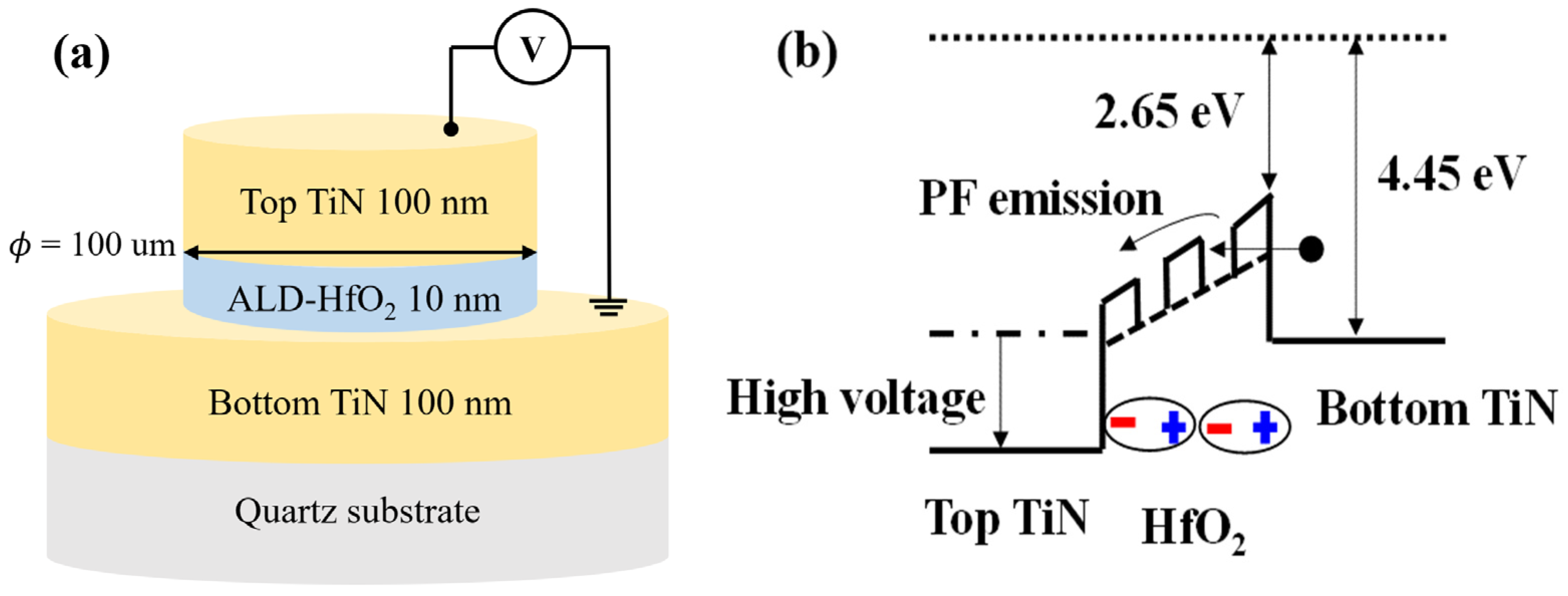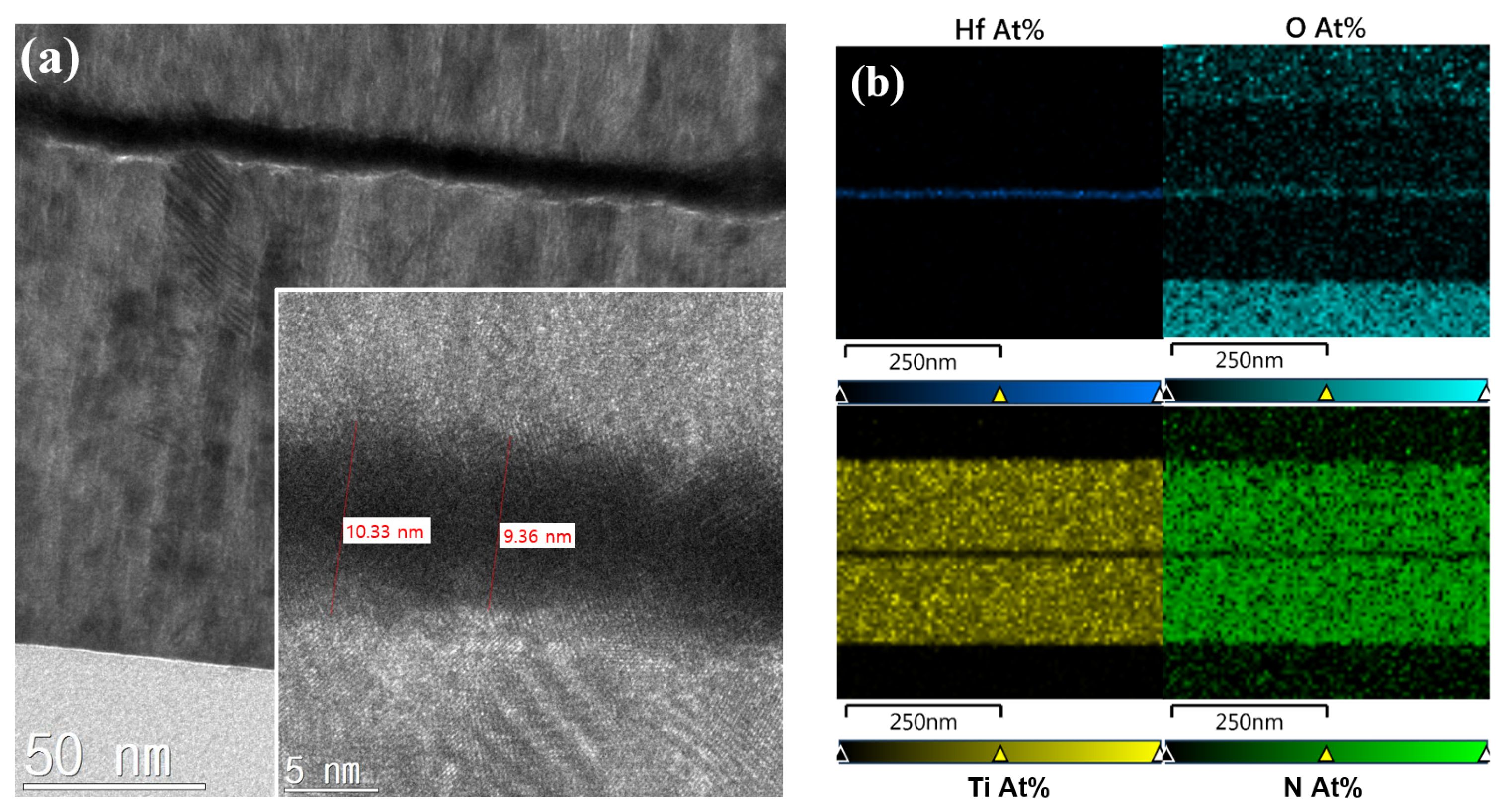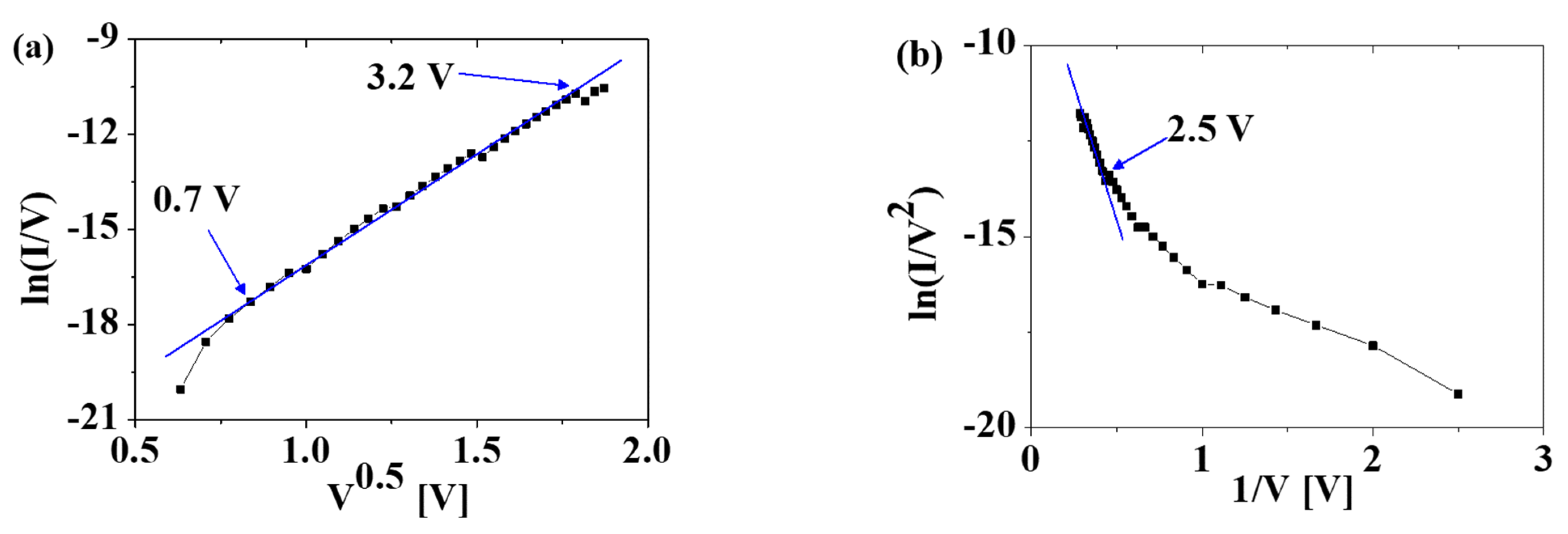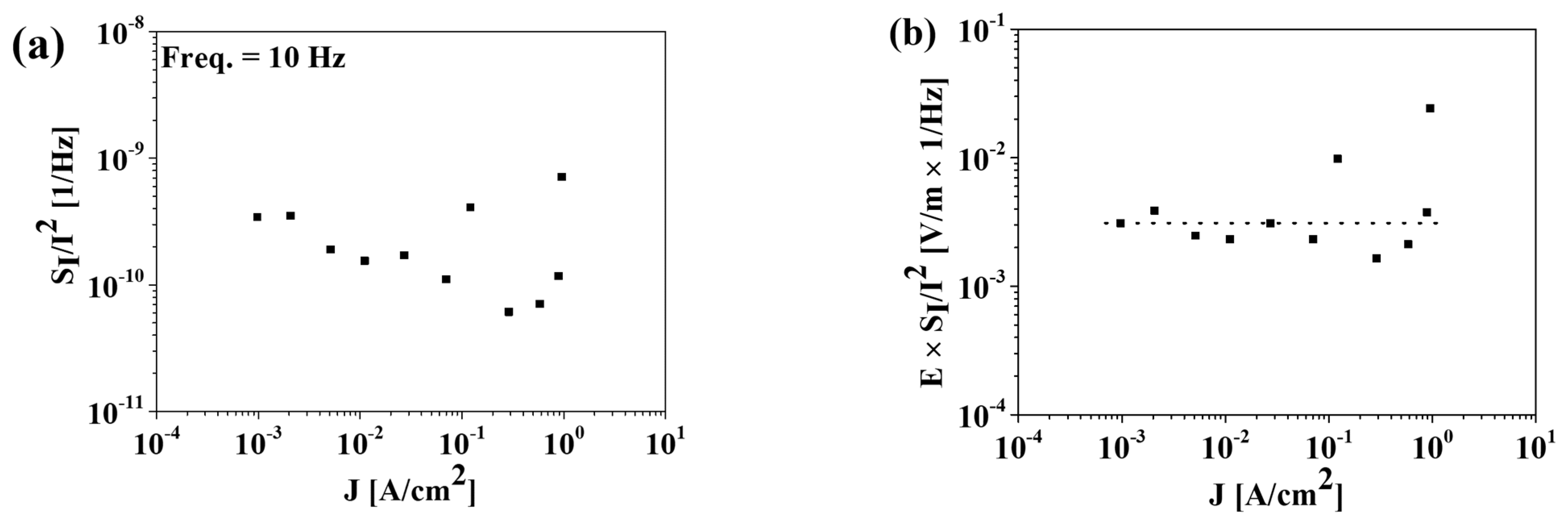Low-Frequency Noise Characteristics in HfO2-Based Metal-Ferroelectric-Metal Capacitors
Abstract
1. Introduction
2. Device Fabrication
3. Characterization and Discussions
4. Conclusions
Author Contributions
Funding
Institutional Review Board Statement
Informed Consent Statement
Data Availability Statement
Conflicts of Interest
References
- Li, S.; Zhou, D.; Shi, Z.; Hoffmann, M.; Mikolajick, T.; Schroeder, U. Involvement of unsaturated switching in the endurance cycling of Si-doped HfO2 ferroelectric thin films. Adv. Electron. Mater. 2020, 6, 2000264. [Google Scholar] [CrossRef]
- Fan, Z.; Chen, J.; Wang, J. Ferroelectric HfO2-based materials for next-generation ferroelectric memories. J. Adv. Dielectr. 2016, 6, 1630003. [Google Scholar] [CrossRef]
- Khan, A.I.; Chatterjee, K.; Wang, B.; Drapcho, S.; You, L.; Serrao, C.; Bakaul, S.R.; Ramesh, R.; Salahuddin, S. Negative capacitance in a ferroelectric capacitor. Nat. Mater. 2015, 14, 182–186. [Google Scholar] [CrossRef] [PubMed]
- Schroeder, U.; Park, M.H.; Mikolajick, T.; Hwang, C.S. The fundamentals and applications of ferroelectric HfO2. Nat. Rev. Mater. 2022, 7, 653–669. [Google Scholar] [CrossRef]
- Jang, C.-H.; Kim, H.-S.; Kim, H.; Cha, H.-Y. Temperature- and Frequency-Dependent Ferroelectric Characteristics of Metal-Ferroelectric-Metal Capacitors with Atomic-Layer-Deposited Undoped HfO2 Films. Materials 2022, 15, 2097. [Google Scholar] [CrossRef] [PubMed]
- Giusi, G.; Aoulaiche, M.; Swerts, J.; Popovici, M.; Redolfi, A.; Simoen, E.; Jurczak, M. Impact of Electrode Composition and Processing on the Low-Frequency Noise in SrTiO3 MIM Capacitors. IEEE Electron Device Lett. 2014, 35, 942–944. [Google Scholar] [CrossRef]
- Shin, W.; Bae, J.-H.; Kim, S.; Lee, K.; Kwon, D.; Park, B.-G.; Kwon, D.; Lee, J.-H. Effects of High-Pressure Annealing on the Low-Frequency Noise Characteristics in Ferroelectric FET. IEEE Electron Device Lett. 2022, 43, 13–16. [Google Scholar] [CrossRef]
- Shin, W.; Bae, J.-H.; Kwon, D.; Koo, R.-H.; Park, B.-G.; Kwon, D.; Lee, J.-H. Investigation of Low-Frequency Noise Characteristics of Ferroelectric Tunnel Junction: From Conduction Mechanism and Scaling Perspectives. IEEE Electron Device Lett. 2022, 43, 958–961. [Google Scholar] [CrossRef]
- Shin, W.; Min, K.K.; Bae, J.-H.; Yim, J.; Kwon, D.; Kim, Y.; Yu, J.; Hwang, J.; Park, B.-G.; Kwon, D.; et al. Comprehensive and accurate analysis of the working principle in ferroelectric tunnel junctions using low-frequency noise spectroscopy. Nanoscale 2022, 14, 2177–2185. [Google Scholar] [CrossRef]
- Chroboczek, J.A.; Piantino, G. Low Noise Current Amplifier with Programmable Gain and Polarization for Use in Electrical Measurement of Semiconductor Circuits, such as Transistors, with the Circuit Being Low Noise and Having a Protection Circuit for the Input. France Patent No. 15075, 22 November 2000. [Google Scholar]
- Kim, K.-W.; Jung, S.-D.; Kim, D.-S.; Kang, H.-S.; Im, K.-S.; Oh, J.-J.; Ha, J.-B.; Shin, J.-K.; Lee, J.-H. Effects of TMAH Treatment on Device Performance of Normally Off Al2O3/GaN MOSFET. IEEE Electron Device Lett. 2011, 32, 1376–1378. [Google Scholar] [CrossRef]
- Angelis, C.T.; Dimitriadis, C.A.; Samaras, I.; Brini, J.; Kamarinos, G.; Gueorguiev, V.K.; Ivanov, T.E. Study of leakage current in n -channel and p -channel polycrystalline silicon thin-film transistors by conduction and low frequency noise measurements. J. Appl. Phys. 1997, 82, 4095–4101. [Google Scholar] [CrossRef]
- Neri, B.; Olivo, P.; Riccò, B. Low-frequency noise in silicon-gate metal-oxide-silicon capacitors before oxide breakdown. Appl. Phys. Lett. 1987, 51, 2167–2169. [Google Scholar] [CrossRef]
- Simoen, E.; Vanhellemont, J.; Claeys, C. The low-frequency noise behaviour of Si n+ p junction diodes fabricated on (1 0 0) and (1 1 1) substrates. Phys. B Condens. Matter. 1996, 228, 219–225. [Google Scholar] [CrossRef]
- Crupi, F.; Giusi, G.; Iannaccone, G.; Magnone, P.; Pace, C.; Simoen, E.; Claeys, C. Analytical model for the noise in the tunneling current through metal-oxide semiconductor structures. J. Appl. Phys. 2009, 106, 073710. [Google Scholar] [CrossRef]
- Simoen, E.; Ritzenthaler, R.; Schram, T.; Horiguchi, N.; Jurczak, M.; Thean, A.; Claeys, C.; Aoulaiche, M.; Spessot, A.; Fazan, P. Low-frequency noise of advanced memory devices. In Proceedings of the International Conference on Noise and Fluctuations (ICNF), Xi’an, China, 2–6 June 2015. [Google Scholar] [CrossRef]
- Mondon, F.; Blonkowski, S. Electrical characterization and reliability of HfO2 and Al2O3–HfO2 MIM capacitors. Microelectron. Reliab. 2003, 43, 1259–1266. [Google Scholar] [CrossRef]
- Kang, S.C.; Lee, S.K.; Kim, S.M.; Hwang, H.J.; Lee, B.H. Quantitative defect density extraction method for metal-insulator-metal capacitor. Semicond. Sci. Technol. 2020, 35, 115025. [Google Scholar] [CrossRef]







Publisher’s Note: MDPI stays neutral with regard to jurisdictional claims in published maps and institutional affiliations. |
© 2022 by the authors. Licensee MDPI, Basel, Switzerland. This article is an open access article distributed under the terms and conditions of the Creative Commons Attribution (CC BY) license (https://creativecommons.org/licenses/by/4.0/).
Share and Cite
Im, K.-S.; Shin, S.; Jang, C.-H.; Cha, H.-Y. Low-Frequency Noise Characteristics in HfO2-Based Metal-Ferroelectric-Metal Capacitors. Materials 2022, 15, 7475. https://doi.org/10.3390/ma15217475
Im K-S, Shin S, Jang C-H, Cha H-Y. Low-Frequency Noise Characteristics in HfO2-Based Metal-Ferroelectric-Metal Capacitors. Materials. 2022; 15(21):7475. https://doi.org/10.3390/ma15217475
Chicago/Turabian StyleIm, Ki-Sik, Seungheon Shin, Chan-Hee Jang, and Ho-Young Cha. 2022. "Low-Frequency Noise Characteristics in HfO2-Based Metal-Ferroelectric-Metal Capacitors" Materials 15, no. 21: 7475. https://doi.org/10.3390/ma15217475
APA StyleIm, K.-S., Shin, S., Jang, C.-H., & Cha, H.-Y. (2022). Low-Frequency Noise Characteristics in HfO2-Based Metal-Ferroelectric-Metal Capacitors. Materials, 15(21), 7475. https://doi.org/10.3390/ma15217475




